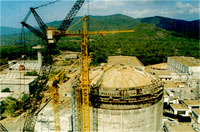|
New Delhi: With only two workers receiving the uppermost limit of radiation of three rem (röntgen equivalent, man) a year in an emergency, the Nuclear Power Corporation of India has confirmed that none of the sixty five workers has been hospitalised because of radiation leak at the Kaiga Atomic Power Station in Karnataka. Focus has shifted instead to identifying the source of what is now being considered to be an ''insider job.''  The source of the ''leak,'' according to reports, has been traced to vials kept in labs within the complex. These vials contain heavy water, used as a coolant in the nuclear plant, and are collected for lab tests. It is now being surmised that some vials of tritiated heavy water were diverted to ``spike'' a water cooler instead of being released into specified areas. The source of the ''leak,'' according to reports, has been traced to vials kept in labs within the complex. These vials contain heavy water, used as a coolant in the nuclear plant, and are collected for lab tests. It is now being surmised that some vials of tritiated heavy water were diverted to ``spike'' a water cooler instead of being released into specified areas.
Tritium is a radioactive isotope of hydrogen, which is used for research, and in fusion reactors and neutron generators. The tritiated heavy water was apparently pushed into the cooler through an outflow pipe as the machine itself is sealed. Authorities are working on the assumption that the act was carried out by a disgruntled nuclear scientist. The water cooler is located outside the reactor area and was found contaminated by radioactivity on the night of 24 November. ``The staff who had access to vials and the various points in the chain where the vials could have been diverted are being examined,'' said MoS in PMO, Prithviraj Chavan. Senior nuclear scientists emphasized there was no radiation leak in the plant itself. Unit 1 of the Kaiga Atomic Power Station has been shut down for annual maintenance since 20 October and around 500 workers are involved in the maintenance work, many of whom are contract workers. According to Kaiga station director JP Gupta , "We have a list of the people who had entered the reactor building that day. The investigating agencies are analysing the data," he said. Kaiga has are four reactors, each with a capacity to generate 220 MW. While three units are operational, the fourth one is expected to go on stream soon. According to the outgoing Atomic Energy Commission chief, Anil Kakodkar, investigations are now focusing on two angles, with authorities working to identify the worker who contaminated the water cooler with tritiated water, as well as reviewing security aspects related to radiation hazard. Kakodkar said normally small quantities of tritiated heavy water are tested for chemical parameters. Investigation According to chairman and managing director of NPCIL, S K Jain, the water cooler had been padlocked and the person in charge of maintenance on the night of November 24 was being examined. He also said that the whole area has computer-accessed control and so it was likely that in the course of time authorities would be able to narrow down on the person who conducted the act of sabotage. According to Jain, he was confident that from ''the details of the computerised access system, we will be able to identify the mischievous element,'' and ''the punishment for causing the incident will be severe.'' The probe into the leak runs into an initial hurdle as authorities realise that there is no CCTV camera installed in front of the water cooler. Authorities say they are working with footage of other nearby areas and log books. Intelligence Bureau officials will also be looking to examine finger prints on the cooler. The finger prints will then be matched with the data available on the plant's biometric security system. Maintenance staff and engineers are also being questioned. According to sources, the list of suspects has been narrowed down to 10-15 persons so far. According to Jain, "It will not be difficult to narrow down possible suspects and with the help of all the intelligence agencies we will be in a position to find the culprit and then come to know the motive - whether it was just some grievance or some other causes," he said. NPCIL sources also said that the water cooler served both Kaiga 1 and 2 units, which are 220 megawatt pressurized heavy water reactors. Preliminary investigations are being conducted by the Atomic Energy Regulatory Board and NPC.
|